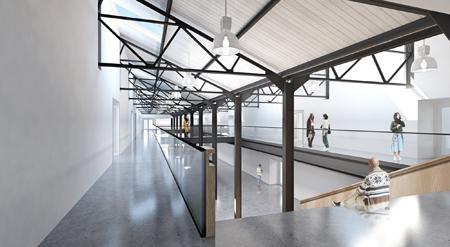REPORT: San Francisco
by Leora Lutz
In 2001, the tech industry bubble burst in San Francisco, and galleries reaped the benefits, renting in buildings previously unaffordable; gathering in critical mass at 49 Geary and nearby 77 Geary downtown. Just 13 years later, the tech explosion has now pushed many of those same galleries out, forcing them to close or to scatter across the city. Art enthusiasts Deborah and Andy Rappaport became frustrated with the rise of real estate costs, which were negatively impacting their beloved art scene. Deborah has served on many boards and committees of regional art organizations and institutions, including the San Jose Museum of Art and The Headlands Center for the Arts, and Andy is a retired tech industry veteran; together they are art collectors and art business entrepreneurs. Eager for a solution, they started asking questions about gallery business models: "Does it make sense to pay exorbitant rents when most of the sales are done through art fairs?" and "Does it make sense to be an island—a destination with no other art neighbors?" With the definitive answers to these questions as "No," they came up with a solution that is now nearing reality; currently under construction in San Francisco's Dogpatch neighborhood, they are building a multi-gallery space called Minnesota Street Project, which is scheduled to open in early 2016.
Dogpatch is an historic seaport district of San Francisco located east of Potrero, whose streets are peppered with turn of the last century cottages and overgrown trees. There is also a booming warehouse conversion area including artists' studios, restaurants, living spaces and industry all comingling. "Unlike LA, New York, Chicago for example— San Francisco isn't sprawling into the suburbs—we have to make it happen here," Deborah Rappaport shares, while chatting at Philz Coffee, across the street from the project construction site. And the Rappaports are championing fair and equitable rents to help people stay. The tenants are guaranteed a three-year lease at onequarter to one-third below market rates with no increase for the three-year term and an option to renew with an increase of no more than 3% per year for the life of the project. With less stress to sell and make ends meet, galleries can take more curatorial risks or expand their offerings. "Our first order of business is to increase the likelihood of success for our tenants," Rappaport emphasized.
The 35,000 square foot space on Minnesota Street will include two floors of commercial gallery spaces, a dark media gallery to show films, bleacher seating for talks, a café, and a curated atrium in the center. There will also be common restrooms, bike storage, showers, communal break room and staff kitchen, a shared conference room and even a packing and shipping room with cubbies for each tenant equipped with brown wrapping paper. With such care to detail—to have the basic business needs of galleries met and encouraging interaction by design—Minnesota Street fosters the growth of a community model for galleries.
And the community is quickly growing. To date, confirmed tenants include Rena Bransten Projects, Nancy Toomey, Eleanor Harwood, Themes + Projects (previously Modernbook), Jack Fischer and SFArtsED. The Rappaports are confident that the spaces will be at full capacity soon, and are broadening their final searches to include young galleries who are ready for a larger space. One of the big light bulb moments came to the Rappaports when they were thinking about the limitations that some galleries face in terms of the kinds of work they show, be they space or curatorial focus. Fischer will be opening a satellite gallery space that will provide new opportunities not possible at his main location on Potrero Avenue. Auxiliary spaces will be available for tenants to rent on an as-needed basis for the same price they pay for their regular leased gallery space. And if that's not enough, there will be a "Special Exhibits" gallery to offer a San Francisco presence for galleries outside of the area.
The whole project is a big undertaking with no previous models to base it on. When the project was in fruition, they reached out to a list of galleries that they know personally: "Tell us why we are out of our minds," Rappaport asked. To their surprise, the response was overwhelmingly positive. "With the Internet, with more art fairs—the old model just doesn't work for a lot of galleries, and it certainly doesn't work for a lot of collectors or entice enough new collectors," Rappaport notes. Although there are a lot of possibly erroneous assumptions about the tech industry not supporting the San Francisco art scene, the Rappaports want to steer clear of assumptions, because there are also people who deserve art in their lives even if they cannot financially invest in it. In addition, new condominiums are "springing up in Dogpatch like mushrooms after a hard rain," Rappaport quips, and with them is a whole new population of people to potentially educate about art. In fact, they believe so strongly in their vision that a second building nearby is already slated to become art studios, storage and services. In the meantime, they are holding exhibitions at a nearby temporary space at 2291 3rd Street while construction is underway.
"It really is incumbent on us—the arts providers—to remove barriers of entry to the arts, not just the tech guys, but the neighbors, single moms with kids or anyone who doesn't realize that the arts are theirs." The Rappaports view Minnesota Street as a place where people can learn about art as well as enrich the knowledge they already have and "integrate art into their daily lives." Staying active and involved with how they can make an impact with their time and resources is at the heart of what inspired Minnesota Street Projects. "Andy and I joke, that we are failing miserably at retirement!" she confides, laughingly. "I don't want to live in a city that doesn't have a vibrant arts community." Who would?
